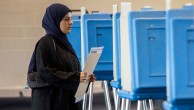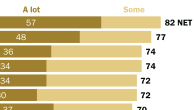This profile provides key demographic information on Latino eligible voters1 and other major groups of eligible voters in Utah.2 All demographic data are based on Pew Hispanic Center tabulations of the U.S. Census Bureau’s 2010 American Community Survey.3
Hispanics in Utah’s Eligible Voter Population
- The Hispanic population in Utah is ranked 34th in the nation.4 About 362,000 Hispanics reside in Utah, 0.7% of all Hispanics in the United States.
- Utah’s population is 13% Hispanic, the 12th largest Hispanic population share nationally.
- There are 123,000 Hispanic eligible voters in Utah—which ranks 24th in Hispanic eligible voter population nationally. California ranks first with 5.9 million.
- Some 7% of Utah eligible voters are Hispanic, the 14th largest Hispanic eligible voter share nationally. New Mexico ranks first with 39%.
- More than one-in-three (34%) Hispanics in Utah are eligible to vote, ranking Utah 35th nationwide in the share of the Hispanic population that is eligible to vote. By contrast, 70% of the state’s white population is eligible to vote.

Characteristics of Eligible Voters
- Age. About four-in-ten Hispanic eligible voters in Utah (39%) are ages 18 to 29, greater than the share of all Latino eligible voters nationwide (33%) in that age range. By contrast, only 29% of all Utah eligible voters and 22% of all U.S. eligible voters are ages 18 to 29.
- Citizenship and Nativity. Among Hispanic eligible voters in Utah, 24% are naturalized U.S. citizens, about the same as Hispanic eligible voters in the nation (25%). Only 4% of all eligible voters in Utah are naturalized citizens, as are 8% of all U.S. eligible voters.
- Hispanic Origin. Like Hispanic eligible voters nationwide, a majority of Hispanic eligible voters in Utah are Mexican. About seven-in-ten (69%) Hispanic eligible voters in Utah are of Mexican origin, compared to 59% in the total U.S. Puerto Ricans compose 3% of the Hispanic eligible voter population in Utah, compared to 14% in the nation as a whole. Fully 28% of Hispanics in Utah are of another Hispanic origin, compared to 26% of Hispanics nationwide.
- Educational Attainment. One-in-four Latino eligible voters in Utah (25%) have not completed high school, more than triple the 8% of all Utah eligible voters who have not completed high school.
- Homeownership. More than half of Hispanic eligible voters in Utah (59%) live in owner-occupied homes, just above the share of all Hispanic eligible voters nationwide (58%). Greater shares of all eligible voters in Utah (73%) and all eligible voters nationwide (69%) live in owner-occupied homes.

Characteristics of Eligible Voters in Utah, by Race and Ethnicity
- Number of Eligible Voters. White eligible voters outnumber Hispanic eligible voters in Utah by more than 12 to 1. There are about five times as many Hispanic eligible voters as Asian eligible voters in the state.
- Age. Latino eligible voters are younger than white and Asian eligible voters in Utah. Nearly four-in-ten (39%) Latinos are ages 18 to 29, compared with 27% of white eligible voters and 25% of Asian eligible voters.
- Educational Attainment. Hispanic eligible voters have lower levels of education than do Asian and white eligible voters in Utah. Fully 25% of Hispanic eligible voters have not obtained a high school diploma, compared with 7% of Asian eligible voters and 6% of white eligible voters.
- Homeownership. Less than six-in-ten (59%) Hispanic eligible voters in Utah live in owner-occupied homes. This is a smaller rate than that of eligible voters in Utah who are Asian (80%) or white (75%).





